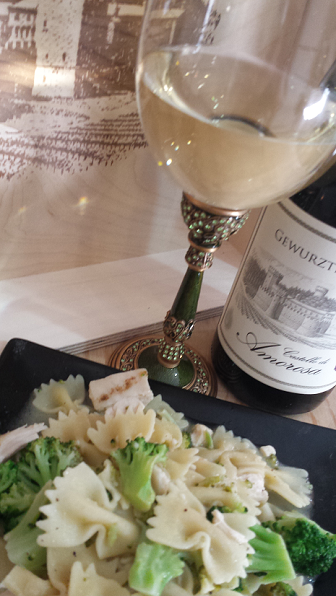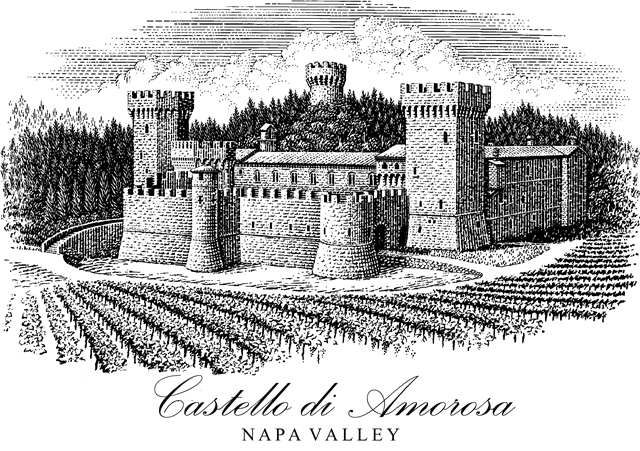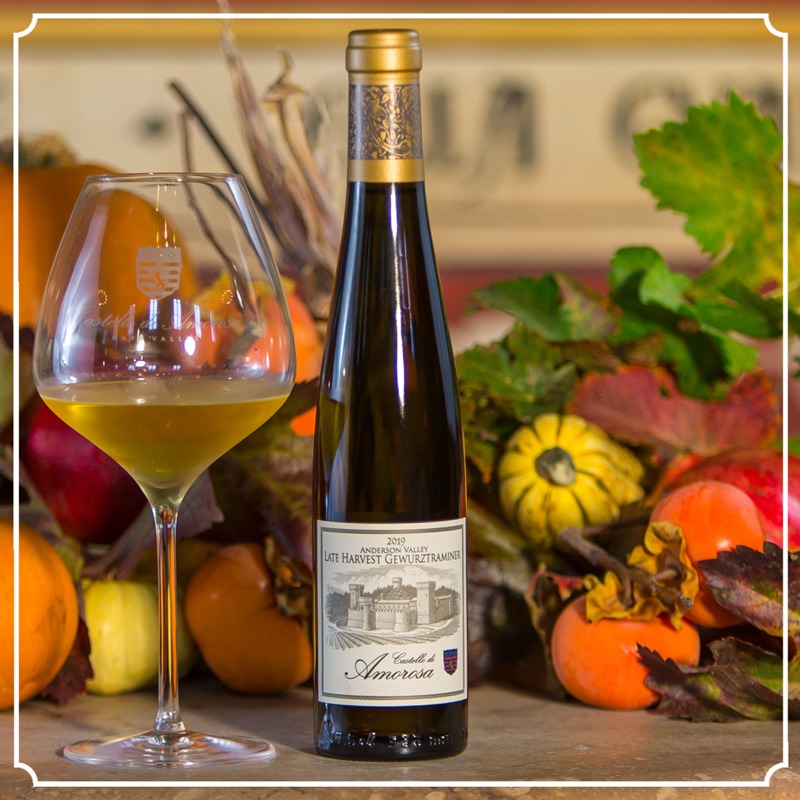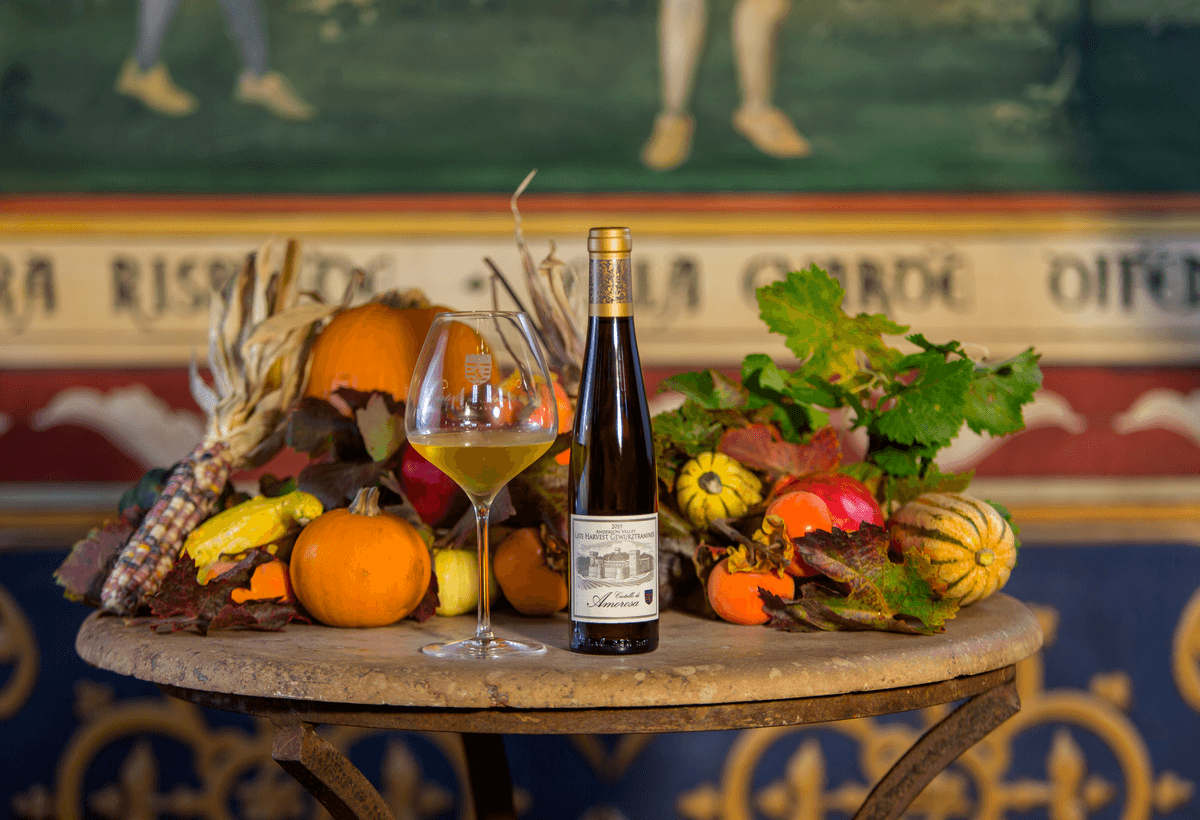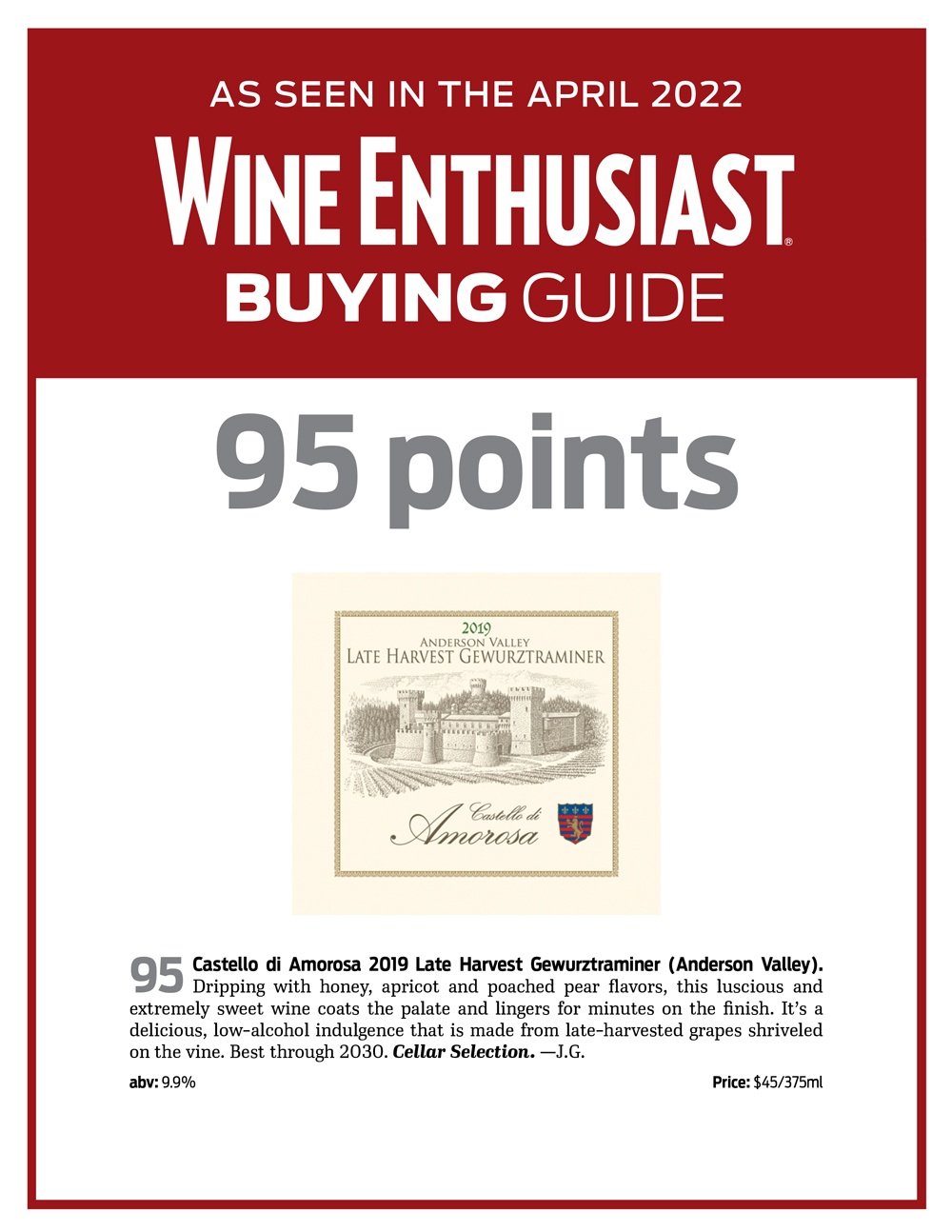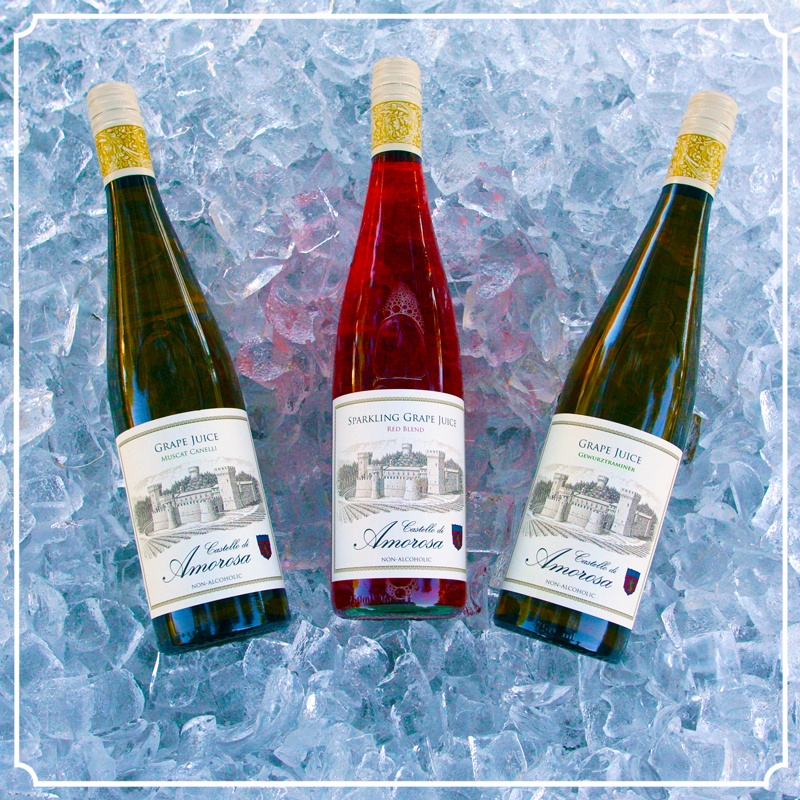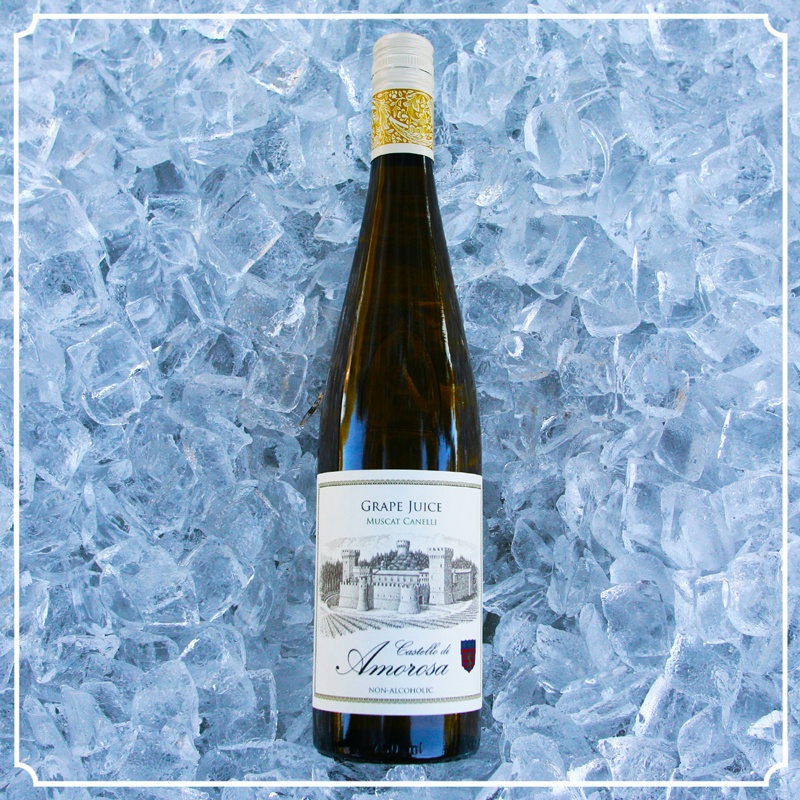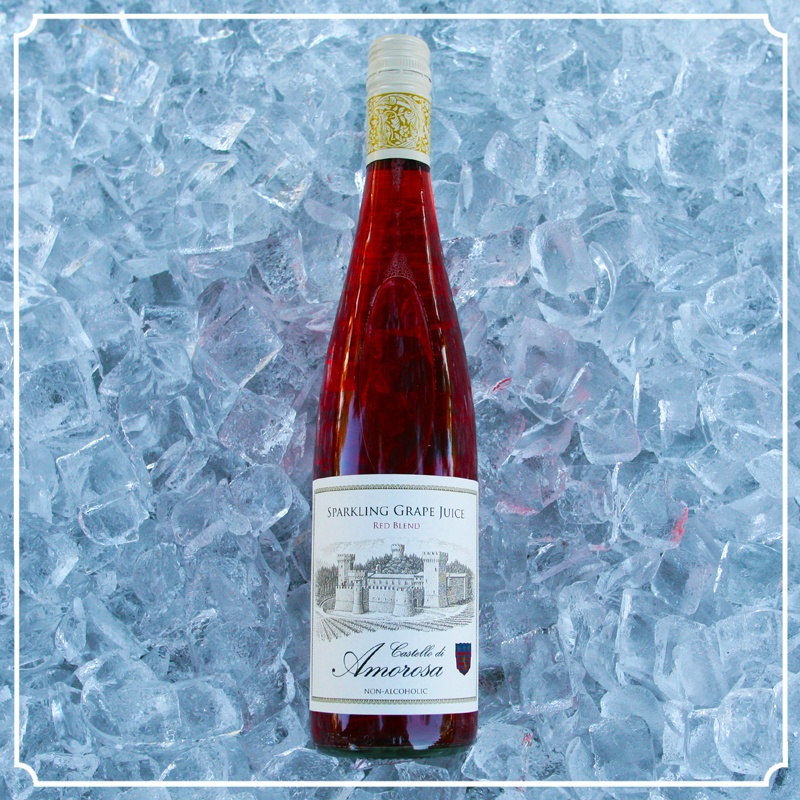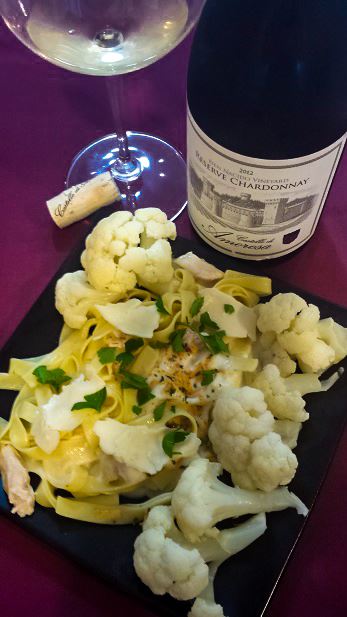Highest Scoring Sweet Wine Ever

Bradley Aden
For The Love of Late Harvest!
We want to take the time & celebrate our highest scoring sweet wine in Castle History, our 2019 Late Harvest Gewürztraminer. Hailing from our Boonville Ranch Vineyard, this wine was awarded a 95 Point, Cellar Selection by Wine Enthusiast Magazine.
Please join us in congratulating our entire winemaking team, including head winemakers Brooks Painter & Peter Velleno for their hard work. Special thanks to our vineyard manager David Bejar who oversees Castello properties year-round.
95 Point – Cellar Selection, Wine Enthusiast Magazine
“Dripping with honey, apricot and poached pear flavors, this luscious and extremely sweet wine coats the palate and lingers for minutes on the finish. It’s a delicious, low-alcohol indulgence that is made from late-harvest grapes shriveled on the vine. Best through 2030. Cellar Selection”
Late Harvest Wine Notes
Tasting Notes: A succulent and deliciously spicy white wine loaded with aroma and flavor, made in a “Noble Rot” dessert, or very sweet, style. Deep straw in color, the wine displays hints of peach, apricot and toffee with a undertone of honey.
Late Harvest Notes: Typically harvested at nearly 32 Brix or more with residual sugar levels close to 13%, this succulent dessert wine is a perennial favorite. A regal dessert wine made from overripe grapes which develop Botrytis cincerea, or “Noble Rot”, shriveling the skins and enhancing sugar, acid and flavor intensity. The resulting harvest in late autumn is vastly diminished in yield, resulting in more concentration and flavor. Made in the style of some of the world’s greatest dessert wines, such as Sauternes and the “dried grape” white wines of Sicily such as “Passito di Pantelleria”.
Food Pairing: Ideal with after dinner desserts of chocolate torte, crème brulee or baked fruit with an artisanal cheese selection.
Past Awards:
2013 Vintage – 92 Points “Editor’s Choice” Wine Enthusiast Jim Gordon
2014 Vintage – SF Chronicle Wine Competition Best of Class
2015 Vintage – SF Chronicle Wine Competition Best of Class
2017 Vintage – 93 pts American Fine Wine Competition
2018 Vintage – SF Chronicle Gold Medal
Boonville Ranch, Anderson Valley
This Castello Estate vineyard is located just south of the town Boonville in Anderson Valley, a coastal valley region famed for Burgundian and Alsatian varieties. This 34 acre ranch was planted in the late 1990’s with Pinot Noir, Pinot Grigio, Gewürztraminer, and Riesling. We pick Gewürztraminer after the grapes have developed a pink to reddish hue, and the aromas are effuse with rose petals, cinnamon spice and exotic lychee fruit. We handle the fruit very carefully, avoiding the bitter tannins as much as possible.
Gewürztraminer hails from the Anderson Valley, which straddles Sonoma and Mendocino Counties. The area is breathtaking and remains quite rural. As one follows the Navarro River, it is not uncommon to spot red-tail hawks, an occasional osprey, or even, if you are lucky, a Golden Eagle. The corridor to the coast (Highway 128) and the picturesque town of Mendocino, perched on a 300-foot cliff overlooking the Pacific, are being discovered and becoming increasingly popular with tourists. Cool climate-loving grapes thrive here because of the lay of the land and strong coastal influence; it has been referred to as ‘California’s Alsace.’ Castello di Amorosa’s estate vineyard lies just to the east of Boonville. Approaching the ocean, the region becomes cooler as one moves westward. West of Boonville is a great Champagne country, but the entire area is also ideal for Riesling and Gewürztraminer.
This white wine is fruity and refreshing yet provides complexity and is appropriate as an aperitif as well as an excellent partner with aggressively flavored or spicy foods like Indian and Asian cuisines with curry or ginger. In America, we often think of Gewürztraminer in the fall when we serve spicy aromatic dishes enhanced with nutmeg, cinnamon, and clove. From our Anderson Valley estate, our winemakers concentrate on making three distinct styles of Gewürztraminer. Ranging from near dry to a sweeter desert style.
What Is Gewurztraminer?

Bradley Aden

What is Gewürztraminer?
History
Gewürztraminer is a popular white wine variety known around the world, treasured for its intense floral aromas and stunning flavor profile. The varietal originated centuries ago around Germany. Known for its lychee and pineapple notes, the wine has a low acidity and is always served cold around 43 Fahrenheit. The grape is a versatile varietal that can be used to make many different styles of wine. Sweetness levels can vary from dry to sweet. Most Gewürztraminer wine is off-dry with just a touch of sweetness.
German can be quite redundant as a language, often running several words together; to make matters more confusing, the Gewürztraminer wine is historically Italian. In Italy near the apex of the Adige Valley on the shores of Lake Balzano is an area only a few miles from the Austrian border. The land has been occupied by Austria several times. The name of this town is Tramin. Because of this cross-culturization every mountain, river, street, town or other landmark is named in Italian AND German and the denizens of this region are bilingual. To translate the name of the town is Tramin and “er” means from in German. Gewürz is German for “spice”. There you have it… “the spiced grape from Tramin:” GEWÜRZTRAMINER (guh-VURTS-trah-mee-ner)
This early-ripening grape can be found in a number of the coolest grape-growing regions in the world: Germany, Austria, Alsace and in Italy’s Trentino Alto-Adige. California’s Los Carneros region, Anderson Valley and Monterey County also produce superior Gewürztraminer. The white wine is known for its crisp, spicy attributes, intense fragrance, and deep color.
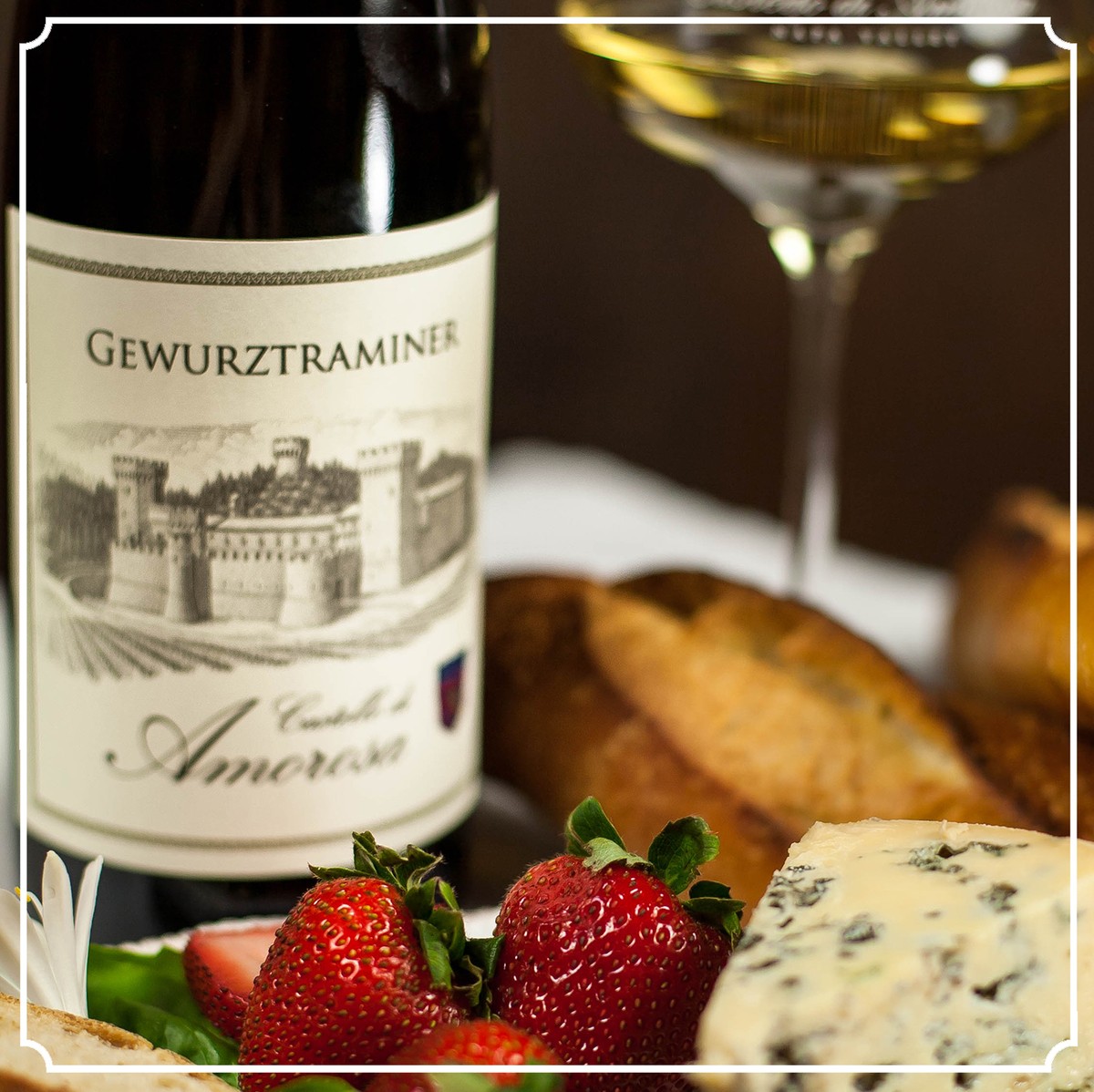
Gewürztraminer Tasting Notes
Historically Gewürztraminer expresses lychee, along with ginger and pineapple. The first aroma you’ll come across in Gewürztraminer is its distinct lychee aroma. Additional flavors & aromas explored in Gewürztraminer include berries, citrus, grapefruit, pineapple, peach, apricot, orange, and Cantaloupe. Non-fruit aromas often associated with the varietal include Rose, Honey, Ginger, Incense, Allspice, Cinnamon, and Smoke. Quality examples can age, but most are best enjoyed in their youth to preserve acidity.
Gewürztraminer Food Pairings
The best pairings happen when you step outside of traditional French cuisine and experience other foods of the world. Middle Eastern and Moroccan cuisine. Both of which utilize nuts and dried fruits with roasted meats.
This wine’s wonderful, spicy finish makes it a great match for Thai or Indian cuisine, spicy seafood dishes, well-seasoned dishes or aged and smoked meat. Popular late harvest Gewurtztraminer is ideal with after-dinner desserts of chocolate torte, crème Brulee, or baked fruit with an artisanal cheese selection.
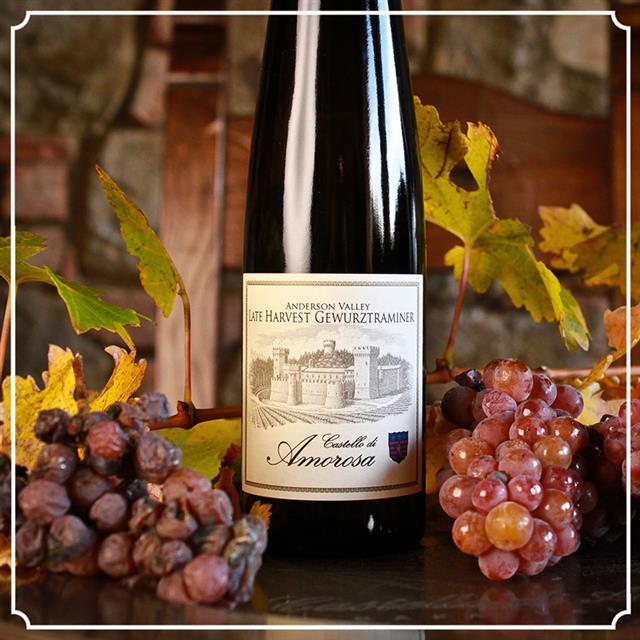
Best Regions for Growing Gewürztraminer
Hailing from the Alsace, located on the border between Germany and France. Gewürztraminer is one of the four grapes varietals found in the Alsace Grand Cru AOC, along with Riesling, Muscat, and Pinot Gris. Gewürztraminer from this appellation is often considered the best, called Vendange Tardive or “late harvest.” It performs best on the heavier, clay soils of Alsace’s Haut-Rhin department, and can quite easily attain the sort of ripeness needed for expensive late harvest bottling. These wines are usually made in a sweeter style and are more suitable for dessert wines, though they bring out complex nutty and spicy flavors.
Austria has almost as much Traminer planted as Germany, with the most successful examples coming mainly from Styria in the far southeast. Alsacian Gewürztraminer accounts for one-quarter of Gewürztraminer grown around the world. It is planted all over eastern and central Europe, called variously Mala Dinka (Bulgaria), Rusa (Romania), Traminac (Slovenia) and Tramini (Hungary, particularly on the rich soils round Lake Balaton).
California’s Los Carneros region, Anderson Valley and Monterey County also produce superior Gewürztraminer. Cool climate loving grapes thrive here because of the lay of the land and strong coastal influence; it has been referred to as ‘California’s Alsace.’
Wines Similar to Gewürztraminer
While Gewürztraminer wine has many similarities to Moscato it also has higher alcohol, more striking aromatics and lower acidity. Other similar wines include, Riesling, Torrontes, Loureiro and Malvasia Bianca.

Castello di Amorosa Gewürztraminer
Castello di Amorosa Gewürztraminer hails from the Anderson Valley, which straddles Sonoma and Mendocino Counties. The area is breathtaking and remains quite rural. As one follows the Navarro River, it is not uncommon to spot red-tail hawks, an occasional osprey, or even, if you are lucky, a Golden Eagle. The corridor to the coast (Highway 128) and the picturesque town of Mendocino, perched on a 300-foot cliff overlooking the Pacific, are being discovered and becoming increasingly popular with tourists. Cool climate-loving grapes thrive here because of the lay of the land and strong coastal influence; it has been referred to as ‘California’s Alsace.’ Castello di Amorosa’s estate vineyard lies just to the east of Boonville. Approaching the ocean, the region becomes cooler as one moves westward. West of Boonville is a great Champagne country, but the entire area is also ideal for Riesling and Gewürztraminer.
This white wine is fruity and refreshing yet provides complexity and is appropriate as an aperitif as well as an excellent partner with aggressively flavored or spicy foods like Indian and Asian cuisines with curry or ginger. In America, we often think of Gewürztraminer in the fall when we serve spicy aromatic dishes enhanced with nutmeg, cinnamon, and clove. From our Anderson Valley estate, our winemakers concentrate on making three distinct styles of Gewürztraminer. Ranging from near dry to a sweeter desert style.
Gewürztraminer (dry)
Like its Austrian and Italian predecessors, our classically styled Gewürztraminer is virtually dry, typically bottled at approximately 7.3 g /L of residual sugar (less than 1%). On the nose it shows floral and spice notes and a palate displaying exotic savory spices and of course, Gewürztraminer’s trademark lychee notes.
Past Awards: 2019 – 90 points Wine Enthusiast | 2017, 2016 & 2014 Best of Class – SF Wine Competition | 2015 SF Chronicle Wine Competition Best White Wine |
Gewürztraminer ‘Dolcino’
Dolce translates to sweet but dolcino means just a little sweet and this is the perfect descriptor for this wine. Usually carrying residual sugar under 40 g/L (4%), this wine is a crowd pleaser for the dry wine lover yet has enough characteristic sweetness to please those with a bent to the sweeties.
Past Awards: 2019 – 90 points Wine Enthusiast | 2016 Double Gold Medal SF Chronicle
Gewürztraminer Late Harvest
Typically harvested at nearly 32 Brix or more with residual sugar levels close to 13%, this succulent dessert wine is a perennial favorite. Sourced from our vineyard in Anderson Valley and made with grapes affected by botrytis cinerea or ‘Noble rot.’
(See Bordeaux/Sauternes).
Past Awards: 2013 – 92 Points “Editor’s Choice” Wine Enthusiast Jim Gordon | 2014 SF Chronicle Wine Competition Best of Class
Best Grape Juice in Napa Valley

Bradley Aden
The Freshest Napa Winery Grape Juice of Them All
Few wineries in Napa Valley are committed to making a natural grape juice. Our grape juice was made in much the same way as our wine. We harvest a few days early to provide a base of acidity. The clusters are hand-harvested, delivered to the crush pad where they are destemmed, pressed and then the juice is chilled to about 32. How long is grape juice good for after opening? “The big difference is we don’t add yeast to convert the grape sugars to alcohol. We skip that step and the result is a great alternative to wine which has surprising age-ability.” Our juices are known for their pure grape flavor and aromatic profiles. This non-alcoholic grape juice is a special addition to your cellar, nature’s true nectar, artfully crafted and delicious for years to come. Stock-up today!
Not Your Supermarket Grape Juice
Can be added with mineral water, sparkling Pellegrino or spring water. Our non-alcoholic grape juices can be consumed on their own as a delicious juice beverage—or add your favorite spirit (gin or vodka) for a fruity, sweet cocktail! It is bottled in a traditional wine bottle with a twist top, for easy reuse. Refrigerate after opening; juice typically remains delicious for several weeks, making it a preferred choice in Napa for non-alcoholic drinkers.
Great Alternative for All Ages
These non-alcoholic grape juices are great alternatives for several occasions. Drinking grape juice supplies the resveratrol and polyphenols (anthocyanins) that the body needs. A great alternative for:
– Children
– Expecting Mothers
– Non-Alcoholic Choice
Our Winemaker Brooks Painter
Castello di Amorosa’s head winemaker Brooks Painter’s career spans more than 40 years. During that time, he’s made hundreds of wines, but making grape juice strikes a special chord, “I have a passion for making grape juice that uses the same grapes that go into our wines,” explained Painter. “The making of a quality grape juice that truly expresses the fruit and flavor of the grape is a challenge, but when the result is a product that is true to the varietal aromas and flavors, I’m happy!” “My challenge,” said Painter, “was to make a grape juice from the same grape that was sensitive of the varietal with its flowery fruit and attractive flavors. It’s intensely aromatic, just like the wine.”
Muscat Canelli Grape Juice
A sweet non-alcoholic treat. Made from 100% Muscat Canelli wine grapes. These grapes make a more flavorful aromatic white grape juice naturally. Our grape juice is made only from fresh, premium-quality Muscat Canelli wine grapes. This is the way real grape juice tastes, superior in aroma, flavor, and health benefits in every respect. Nothing has been added except sulfites to protect the natural aroma and flavors. You won’t find juice of this quality in your local supermarket. Get it while supplies last.
Lucas & Lewellan Vineyard
Harvest Date: 9/6/ to 9/10/18
Bottling Date: 2/1/19
Alcohol %: Zero
Titratable Acidity: 6.6 g/L
pH: 3.31
Red Blend Sparkling Grape Juice
A sparkling and sweet non-alcoholic juice made from a blend of red wine grapes, with a pleasant spritziness that adds an invigorating twist to this delicate premium grape juice. Our sparkling grape juice is made only from fresh, premium-quality grapes, which include 90% Gamay, 5% Grenache, and 5% Cabernet Sauvignon grape varietals. You read that correctly, there is Cabernet Sauvignon in this grape juice. Nothing has been added except sulfites to protect the natural aroma and flavors.
Tamayo Vineyard
Harvest Date: 9/6/18
Bottling Date: 2/1/19
Alcohol %: Zero
Titratable Acidity: 6.6 g/L
pH: 3.33
Gewurztraminer Grape Juice
Our newest addition to the grape juice family will be available for purchase on April 1, 2021. The Gewurztraminer will be the same grapes used from our Anderson Valley Estate Vineyard. Our Gewurztraminer juice provides an elegant alternative that is less sweet than our other offerings.
Anderson Valley Vineyard
Harvest Date: 9/6/20
Bottling Date: 2/1/21
Alcohol %: Zero
President Georg Salzner Samples Vintage Grape Juice
Deconstructed Albondigas

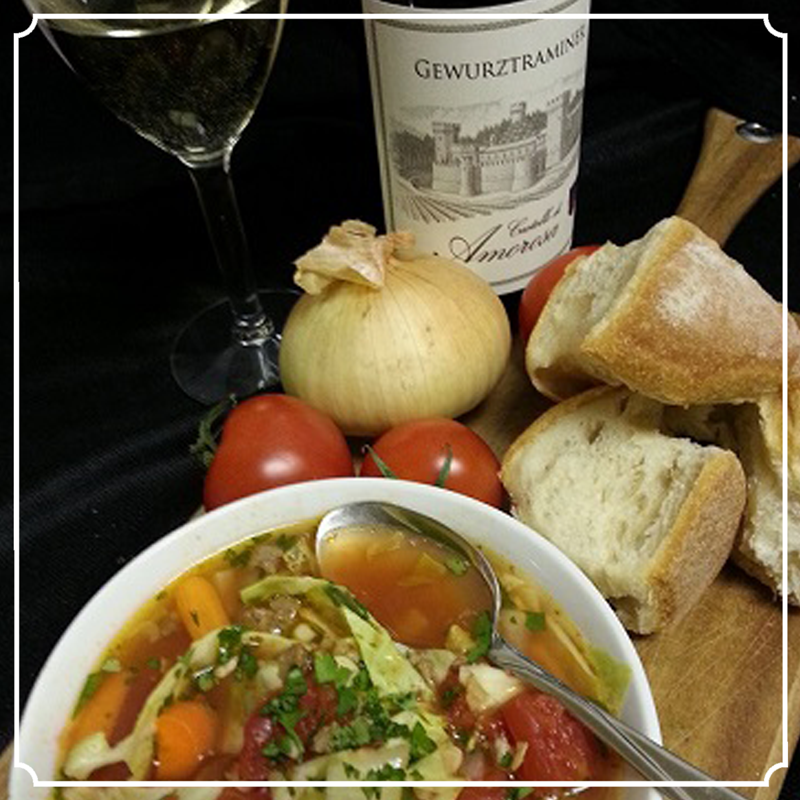
Recipe Date: July 12th, 2020
Difficulty: Easy
Measurements: Imperial (US)
Deconstructed Albondigas Soup Recipe
- 4 cups Beef Broth
- 4 cups Chicken Broth
- 2 Large cans crushed tomatoes (28 oz)
- 2 Large cans diced tomatoes
- 1 lb Ground beef
- 1 lb Spicy sausage
- 2 Heads of cabbage, cored and diced
- 1 Small bag frozen white corn
- 5 Carrots thinly sliced
- 5 Stalks diced celery
- 4 Large cloves minced garlic
- 1 Bunch chopped cilantro (set some aside for garnish)
- 1 Large diced brown onion
Brown ground meat and/or sausage. Add to a large pot with all other ingredients. Cook over medium low heat until vegetables are to desired softness. To accelerate the cooking process, give the veggies a quick sauté before adding to the pot. Stir and taste often and, as always, add seasoning as needed.
Prep Time: 30 mins
Cook Time: 45-60 mins
Related Products – Dry Gewurztraminer
Winter White

Mary Davidek
Winter White Wine | Wine for the Season | Castello di Amorosa
While most of us have a go-to favorite wine taking permanent tenancy in the ‘most preferred’ zone, often we explore other varietals– particularly when entertaining or in my case, looking for the just-right pairing. Entertaining and pleasing guests with diverse palates, seasonal influences, even extreme weather can bring wine-drinking-enjoying challenges. When it is 100 degrees and the mercury is soaring it can be a test to feign enthusiasm about a glass of inky rich Cabernet for the thick Porterhouse grilling on the ‘cue. Likewise, when you spy frost on the pavement and the windshield is icy, a chilled crisp white wine may be less than heart-warming. What to do when some of the satisfying hearty wintertime favorites are rich and creamy and just screaming for…. well….not a red wine.
My winter white is Chardonnay. Specifically, Castello di Amorosa Bien Nacido Vineyard Chardonnay. This is not the ‘Castello sommelier’ pontificating on the many virtues of this award winning chardonnay, this is me, the ‘wine drinker’ who is generally not excited about most California chard.
Castello’s Bien Nacido Vineyard Chardonnay is different—this fruit is exceptional. The vineyard is located on the central coast of California and exposed to the Pacific. The coastal morning fog provides cool temperatures early in the day but warm late afternoons drenched in the Pacific sun. This gives the slow ripening grapes longer hang time on the vines while enjoying the real estate and the luxurious coastal influence. The juice shows its mettle when barrel fermented but not over manipulated so the gorgeous bright backbone of zippy acidity shines through. This balanced chard displays a soft nuttiness with fruit and focus. Juicy Comice pear, white peach and light vanilla flavors; full bodied and rounded–perfect for the rich creamy cold-weather foods we crave.
While winter white wine may not conjure up warm cozy images outside–
when you are inside, winter white can be an absolute delight!
Quick and Easy Chicken Fettuccine Alfredo
♦ ½ lb. fettuccine, uncooked
♦ 1lb. boneless skinless chicken breasts, cut into strips
♦ 4tsp. flour
♦ 1-1/4cups chicken broth
♦ 4oz. Mascarpone ( sub cream cheese)
♦ 1/2 cup Grated Parm, divided
♦ ¼ tsp. garlic powder
♦ 1/4tsp. white pepper
Cook pasta to slightly firm. Sautée chicken in large nonstick skillet on medium-high heat 5 to 7 min. or until done, stirring occasionally. Remove from skillet. Mix flour and broth in same skillet with whisk. Stir in Mascarpone, 2 Tbsp. Parm, garlic powder and pepper; cook 2 min. or until mixture boils and thickens, stirring constantly. Stir in chicken. Drain pasta; place in large bowl. Add chicken mixture; toss to coat. Sprinkle with remaining Parm.
Grasping Gewürztraminer

Mary Davidek
Grasping Gewürztraminer
Gewürztraminer, misunderstood and often mispronounced, how did such a unique grape come to be so abundant in modern winemaking and in such diverse regions?
First of all to understand the grape we must dissect the name itself. The German language can be quite redundant, often running a number of words together to create one word. For a glimpse into this as well as a little fun, try this link– Click Here
(Imagine if Barbara served this with Barbera!)
To complicate this further and make matters even more confusing, Gewürztraminer is actually Italian!
To explain:
Near the tip of the Adige Valley on the shores of Lake Balzano, lies the town of Termeno aka Tramin. Since the area is only a few miles from the Austrian border, and the land has been occupied by Austria several times (pick a war, any war), the town is called Tramin in German. In fact every mountain, river, street, town or other landmark is named in Italian AND German and because of this cross-culture the denizens of this region are bilingual. To translate:
The name of the town is Tramin…
“er” means from in German…
“gewürz” is German for “spice”
There you have it… “the spiced grape from Tramin”
GEWÜRZTRAMINER (guh-VURTS-trah-mee-ner)
To clarify; a German word for an Italian grape grown in Austria, I mean Italy! This is confusing.
Enough with geography– let’s talk wine.
Gewürztraminer is known for its crisp pear and apple notes, spicy attributes, intense fragrance and distinct color. Gewürztraminer is commonly associated with sweet wine, however, Gewürz is made in different styles depending on the level of ripeness at harvest .When picked late in the season like Castello’s Late Harvest Gewürztraminer this wine displays honey-apple with succulent peach nectar-like qualities. Perfect with a not too sweet desert or a cheese course…or combined into one grand finale.
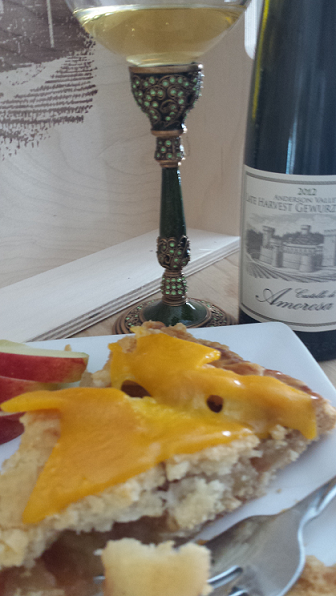
Keep it a bit savory with this sweetie. Remember, apple pie without the cheese is like a kiss without a squeeze.
An off dry or slightly sweet Gewürztraminer like Dolcino is harvested at normal sugar levels and fermented to leave a bit of residual sugar. This is my choice for pairing with spicy main dishes like Andouille Sausage Jambalaya.
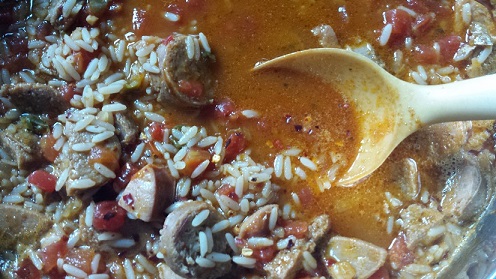
The classic dry Gewürztraminer may be the most versatile and my personal favorite. This wine displays ginger, crisp stone fruits and a tell-tale hint of lychee. Mix it up a bit with this mixed up wine, rich and hearty Italian dishes with savory basil and lemon in a light cream sauce are contrasted perfectly with classic dry Gewürz. Farfalle pasta catches all of the goodness in each and every bite… with a sip of Gerwürz….das schmeckt gut. Or is it delizioso?…well, in any language–yum!
